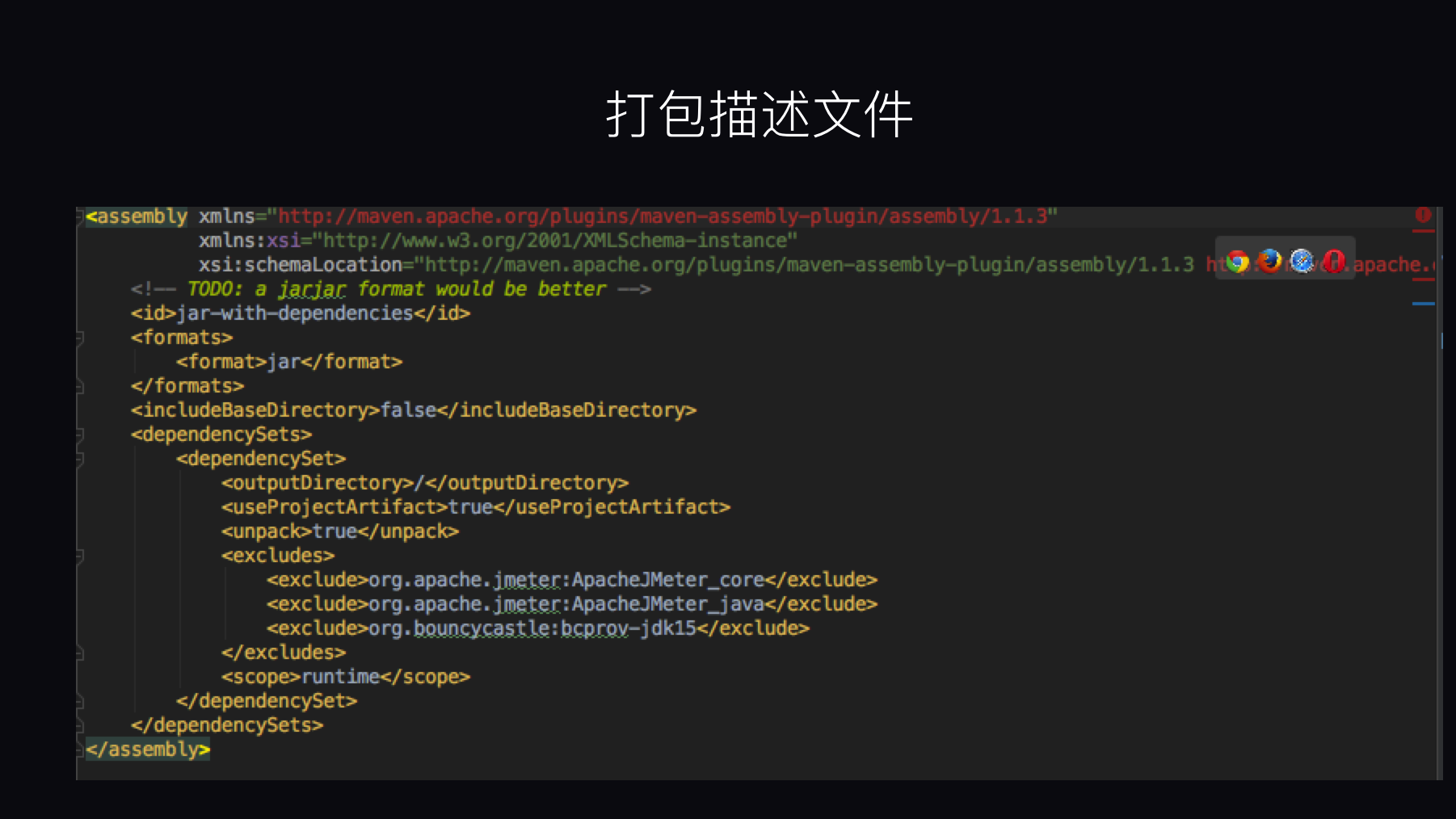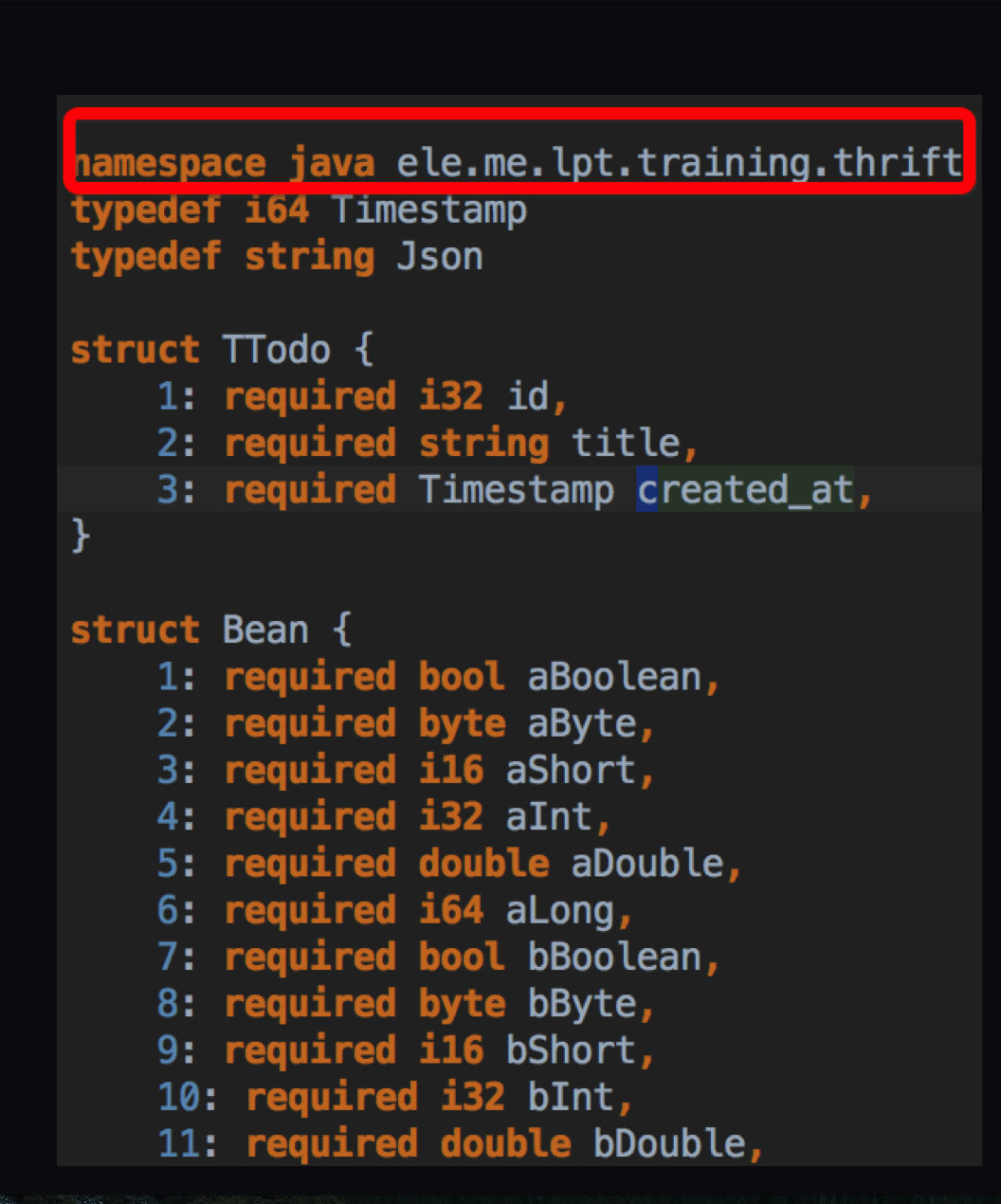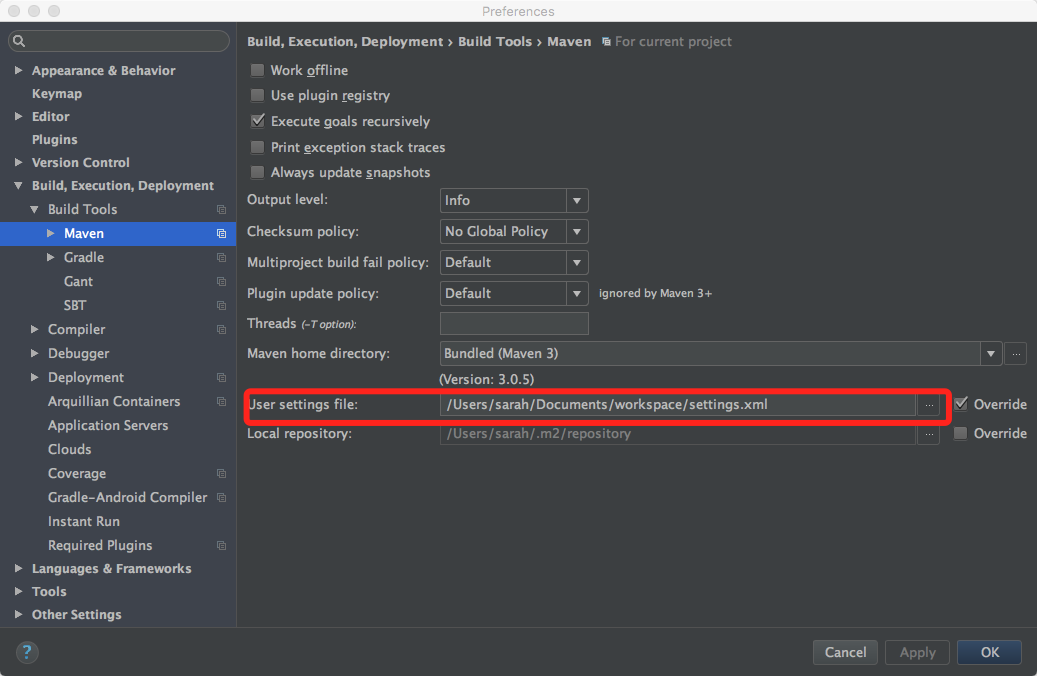Jmeter--thrift接口压测
1. 安装thrift
2. 新建maven工程,代码结构如下

3. pom设置,按配置存放thrift文件和打包描述文件(具体代码见附件,根据需要改变配置信息)


4. thrift需要手动添加namespace

5. mvn clean install -Dmaven.test.skip=true生成java文件
6.新建类继承AbstractJavaSamplerClient
7. 按需求重写getDefaultParameters, setupTest, runTest, teardownTest
8. 改变settings.xml的地址,如下图所示(快捷键:command + ,)(具体代码见附件,根据需要改变文件中的配置信息)

8. 使用Junit调试
9. mvn clean install重新打jar包
10. ${JMETER_HOME}/lib/ext/x.jar存放位置
11. JMeter调试
ps:附件pom.xml
<?xml version="1.0" encoding="UTF-8"?>
<project xmlns="http://maven.apache.org/POM/4.0.0"
xmlns:xsi="http://www.w3.org/2001/XMLSchema-instance"
xsi:schemaLocation="http://maven.apache.org/POM/4.0.0 http://maven.apache.org/xsd/maven-4.0.0.xsd">
<modelVersion>4.0.0</modelVersion> <groupId>clair.tester</groupId>
<artifactId>clair.thrift</artifactId>
<version>1.0</version>
<dependencies> <dependency>
<groupId>org.apache.jmeter</groupId>
<artifactId>ApacheJMeter_core</artifactId>
<version>2.13</version>
</dependency> <dependency>
<groupId>org.apache.jmeter</groupId>
<artifactId>ApacheJMeter_java</artifactId>
<version>2.13</version>
</dependency> <dependency>
<groupId>org.apache.thrift.tools</groupId>
<artifactId>maven-thrift-plugin</artifactId>
<version>0.1.11</version>
</dependency> <dependency>
<groupId>org.apache.thrift</groupId>
<artifactId>libthrift</artifactId>
<version>0.9.2</version>
</dependency> <dependency>
<groupId>junit</groupId>
<artifactId>junit</artifactId>
<version>4.12</version>
</dependency>
</dependencies> <build>
<plugins>
<plugin>
<groupId>org.apache.maven.plugins</groupId>
<artifactId>maven-compiler-plugin</artifactId>
<configuration>
<source>1.8</source>
<target>1.8</target>
</configuration>
</plugin>
<plugin>
<artifactId>maven-assembly-plugin</artifactId>
<configuration>
<finalName>${project.artifactId}</finalName>
<descriptors>
<descriptor>src/assembly/package.xml</descriptor>
</descriptors>
<appendAssemblyId>false</appendAssemblyId>
</configuration>
<executions>
<execution>
<id>make-assembly</id>
<!-- this is used for inheritance merges -->
<phase>package</phase>
<!-- bind to the packaging phase -->
<goals>
<goal>single</goal>
</goals>
</execution>
</executions>
</plugin> <plugin>
<groupId>org.apache.thrift.tools</groupId>
<artifactId>maven-thrift-plugin</artifactId>
<version>0.1.11</version>
<configuration>
<thriftExecutable>/usr/local/bin/thrift</thriftExecutable>
<thriftSourceRoot>src/main/resources</thriftSourceRoot>
<generator>java</generator>
</configuration>
<executions>
<execution>
<id>thrift-sources</id>
<phase>generate-sources</phase>
<goals>
<goal>compile</goal>
</goals>
</execution>
</executions>
</plugin>
</plugins>
</build>
</project>
ps: 附件settings.xml
<?xml version="1.0" encoding="UTF-8"?> <!--
Licensed to the Apache Software Foundation (ASF) under one
or more contributor license agreements. See the NOTICE file
distributed with this work for additional information
regarding copyright ownership. The ASF licenses this file
to you under the Apache License, Version 2.0 (the
"License"); you may not use this file except in compliance
with the License. You may obtain a copy of the License at http://www.apache.org/licenses/LICENSE-2.0 Unless required by applicable law or agreed to in writing,
software distributed under the License is distributed on an
"AS IS" BASIS, WITHOUT WARRANTIES OR CONDITIONS OF ANY
KIND, either express or implied. See the License for the
specific language governing permissions and limitations
under the License.
--> <!--
| This is the configuration file for Maven. It can be specified at two levels:
|
| 1. User Level. This settings.xml file provides configuration for a single user,
| and is normally provided in ${user.home}/.m2/settings.xml.
|
| NOTE: This location can be overridden with the CLI option:
|
| -s /path/to/user/settings.xml
|
| 2. Global Level. This settings.xml file provides configuration for all Maven
| users on a machine (assuming they're all using the same Maven
| installation). It's normally provided in
| ${maven.home}/conf/settings.xml.
|
| NOTE: This location can be overridden with the CLI option:
|
| -gs /path/to/global/settings.xml
|
| The sections in this sample file are intended to give you a running start at
| getting the most out of your Maven installation. Where appropriate, the default
| values (values used when the setting is not specified) are provided.
|
|-->
<settings xmlns="http://maven.apache.org/SETTINGS/1.0.0"
xmlns:xsi="http://www.w3.org/2001/XMLSchema-instance"
xsi:schemaLocation="http://maven.apache.org/SETTINGS/1.0.0 http://maven.apache.org/xsd/settings-1.0.0.xsd">
<!-- localRepository
| The path to the local repository maven will use to store artifacts.
|
| Default: ${user.home}/.m2/repository
<localRepository>/path/to/local/repo</localRepository>
--> <!-- interactiveMode
| This will determine whether maven prompts you when it needs input. If set to false,
| maven will use a sensible default value, perhaps based on some other setting, for
| the parameter in question.
|
| Default: true
<interactiveMode>true</interactiveMode>
--> <!-- offline
| Determines whether maven should attempt to connect to the network when executing a build.
| This will have an effect on artifact downloads, artifact deployment, and others.
|
| Default: false
<offline>false</offline>
--> <!-- pluginGroups
| This is a list of additional group identifiers that will be searched when resolving plugins by their prefix, i.e.
| when invoking a command line like "mvn prefix:goal". Maven will automatically add the group identifiers
| "org.apache.maven.plugins" and "org.codehaus.mojo" if these are not already contained in the list.
|-->
<pluginGroups>
<!-- pluginGroup
| Specifies a further group identifier to use for plugin lookup.
<pluginGroup>com.your.plugins</pluginGroup>
-->
</pluginGroups> <!-- proxies
| This is a list of proxies which can be used on this machine to connect to the network.
| Unless otherwise specified (by system property or command-line switch), the first proxy
| specification in this list marked as active will be used.
|-->
<proxies>
<!-- proxy
| Specification for one proxy, to be used in connecting to the network.
|
<proxy>
<id>optional</id>
<active>true</active>
<protocol>http</protocol>
<username>proxyuser</username>
<password>proxypass</password>
<host>proxy.host.net</host>
<port>80</port>
<nonProxyHosts>local.net|some.host.com</nonProxyHosts>
</proxy>
-->
</proxies> <!-- servers
| This is a list of authentication profiles, keyed by the server-id used within the system.
| Authentication profiles can be used whenever maven must make a connection to a remote server.
|-->
<servers> <server>
<id>archjava</id>
<username>archjava</username>
<password>archjava123</password>
</server> <server>
<id>eleme-pub</id>
<configuration>
<wagonProvider>httpclient</wagonProvider>
<httpConfiguration>
<all>
<connectionTimeout>600000</connectionTimeout>
<readTimeout>600000</readTimeout>
<usePreemptive>true</usePreemptive>
</all>
</httpConfiguration>
</configuration>
</server> <!-- server
| Specifies the authentication information to use when connecting to a particular server, identified by
| a unique name within the system (referred to by the 'id' attribute below).
|
| NOTE: You should either specify username/password OR privateKey/passphrase, since these pairings are
| used together.
|
<server>
<id>deploymentRepo</id>
<username>repouser</username>
<password>repopwd</password>
</server>
--> <!-- Another sample, using keys to authenticate.
<server>
<id>siteServer</id>
<privateKey>/path/to/private/key</privateKey>
<passphrase>optional; leave empty if not used.</passphrase>
</server>
-->
</servers> <!-- mirrors
| This is a list of mirrors to be used in downloading artifacts from remote repositories.
|
| It works like this: a POM may declare a repository to use in resolving certain artifacts.
| However, this repository may have problems with heavy traffic at times, so people have mirrored
| it to several places.
|
| That repository definition will have a unique id, so we can create a mirror reference for that
| repository, to be used as an alternate download site. The mirror site will be the preferred
| server for that repository.
|-->
<mirrors>
<!-- mirror
| Specifies a repository mirror site to use instead of a given repository. The repository that
| this mirror serves has an ID that matches the mirrorOf element of this mirror. IDs are used
| for inheritance and direct lookup purposes, and must be unique across the set of mirrors.
|
<mirror>
<id>mirrorId</id>
<mirrorOf>repositoryId</mirrorOf>
<name>Human Readable Name for this Mirror.</name>
<url>http://my.repository.com/repo/path</url>
</mirror>
--> <mirror>
<id>eleme-pub</id>
<name>eleme-pub</name>
<url>http://maven.dev.xxx.me/nexus/content/groups/public/</url>
<mirrorOf>*</mirrorOf>
</mirror> </mirrors> <!-- profiles
| This is a list of profiles which can be activated in a variety of ways, and which can modify
| the build process. Profiles provided in the settings.xml are intended to provide local machine-
| specific paths and repository locations which allow the build to work in the local environment.
|
| For example, if you have an integration testing plugin - like cactus - that needs to know where
| your Tomcat instance is installed, you can provide a variable here such that the variable is
| dereferenced during the build process to configure the cactus plugin.
|
| As noted above, profiles can be activated in a variety of ways. One way - the activeProfiles
| section of this document (settings.xml) - will be discussed later. Another way essentially
| relies on the detection of a system property, either matching a particular value for the property,
| or merely testing its existence. Profiles can also be activated by JDK version prefix, where a
| value of '1.4' might activate a profile when the build is executed on a JDK version of '1.4.2_07'.
| Finally, the list of active profiles can be specified directly from the command line.
|
| NOTE: For profiles defined in the settings.xml, you are restricted to specifying only artifact
| repositories, plugin repositories, and free-form properties to be used as configuration
| variables for plugins in the POM.
|
|-->
<profiles>
<!-- profile
| Specifies a set of introductions to the build process, to be activated using one or more of the
| mechanisms described above. For inheritance purposes, and to activate profiles via <activatedProfiles/>
| or the command line, profiles have to have an ID that is unique.
|
| An encouraged best practice for profile identification is to use a consistent naming convention
| for profiles, such as 'env-dev', 'env-test', 'env-production', 'user-jdcasey', 'user-brett', etc.
| This will make it more intuitive to understand what the set of introduced profiles is attempting
| to accomplish, particularly when you only have a list of profile id's for debug.
|
| This profile example uses the JDK version to trigger activation, and provides a JDK-specific repo.
<profile>
<id>jdk-1.4</id> <activation>
<jdk>1.4</jdk>
</activation> <repositories>
<repository>
<id>jdk14</id>
<name>Repository for JDK 1.4 builds</name>
<url>http://www.myhost.com/maven/jdk14</url>
<layout>default</layout>
<snapshotPolicy>always</snapshotPolicy>
</repository>
</repositories>
</profile>
--> <profile>
<id>ele-repo-profile</id>
<repositories>
<repository>
<id>snapshot-repo</id>
<url>http://maven.dev.elenet.me/nexus/content/groups/snapshots/</url>
<releases>
<enabled>false</enabled>
</releases>
<snapshots>
<enabled>true</enabled>
<updatePolicy>always</updatePolicy>
</snapshots>
</repository>
</repositories>
<pluginRepositories>
<pluginRepository>
<id>plugin-repo</id>
<name>plugin-repo</name>
<url>http://maven.dev.elenet.me/nexus/content/groups/public/</url>
<releases>
<enabled>true</enabled>
<updatePolicy>always</updatePolicy>
</releases>
<snapshots>
<enabled>false</enabled>
</snapshots>
</pluginRepository>
</pluginRepositories>
</profile> <!--
| Here is another profile, activated by the system property 'target-env' with a value of 'dev',
| which provides a specific path to the Tomcat instance. To use this, your plugin configuration
| might hypothetically look like:
|
| ...
| <plugin>
| <groupId>org.myco.myplugins</groupId>
| <artifactId>myplugin</artifactId>
|
| <configuration>
| <tomcatLocation>${tomcatPath}</tomcatLocation>
| </configuration>
| </plugin>
| ...
|
| NOTE: If you just wanted to inject this configuration whenever someone set 'target-env' to
| anything, you could just leave off the <value/> inside the activation-property.
|
<profile>
<id>env-dev</id> <activation>
<property>
<name>target-env</name>
<value>dev</value>
</property>
</activation> <properties>
<tomcatPath>/path/to/tomcat/instance</tomcatPath>
</properties>
</profile>
-->
</profiles> <!-- activeProfiles
| List of profiles that are active for all builds.
|
<activeProfiles>
<activeProfile>alwaysActiveProfile</activeProfile>
<activeProfile>anotherAlwaysActiveProfile</activeProfile>
</activeProfiles>
--> <activeProfiles>
<activeProfile>xxxxx</activeProfile>
</activeProfiles> </settings>
Jmeter--thrift接口压测的更多相关文章
- Jmeter--thrift接口压测,调用jar包失败报错:java.lang.NoSuchMethodError:
调用thrift接口压测的jar包,出现了错误:java.lang.NoSuchMethodError: 错误可能的原因: 有这个类,该类真的没有这个方法 有这个类,而且有好几个,他们之间发生了冲突 ...
- jmeter接口压测的反思
jmeter接口压测的反思 1.keepalive的坑:连接数满了,导致发起的请求失败. 2.token关联?是数据库取做参数化,还是随机数生成(需要改代码) 3.签名问题如何处理? 4.压测负载机端 ...
- JMeter接口压测和性能监测
JMeter接口压力测试总结 一.安装JMeter 1. 在客户端机器上安装JMeter压测工具,我这里安装的版本是apache-jmeter-5.2.1,由于JMeter是JAVA语言开发的 ...
- 5. 堪比JMeter的.Net压测工具 - Crank 实战篇 - 接口以及场景压测
目录 堪比JMeter的.Net压测工具 - Crank 入门篇 堪比JMeter的.Net压测工具 - Crank 进阶篇 - 认识yml 堪比JMeter的.Net压测工具 - Crank 进阶篇 ...
- Dubbo接口压测
在每年的双十一大促之前,除了全链路压测,还需要各个业务方对自己业务提供的核心接口进行单接口压测,以评判系统的稳定性和承压能力. 一.准备工作 环境准备:确保应用性能环境(perf)正常可用 压测接口梳 ...
- 1. 堪比JMeter的.Net压测工具 - Crank 入门篇
目录 堪比JMeter的.Net压测工具 - Crank 入门篇 堪比JMeter的.Net压测工具 - Crank 进阶篇 - 认识yml 堪比JMeter的.Net压测工具 - Crank 进阶篇 ...
- 2. 堪比JMeter的.Net压测工具 - Crank 进阶篇 - 认识yml
目录 堪比JMeter的.Net压测工具 - Crank 入门篇 堪比JMeter的.Net压测工具 - Crank 进阶篇 - 认识yml 堪比JMeter的.Net压测工具 - Crank 进阶篇 ...
- 3. 堪比JMeter的.Net压测工具 - Crank 进阶篇 - 认识bombardier
目录 堪比JMeter的.Net压测工具 - Crank 入门篇 堪比JMeter的.Net压测工具 - Crank 进阶篇 - 认识yml 堪比JMeter的.Net压测工具 - Crank 进阶篇 ...
- 4. 堪比JMeter的.Net压测工具 - Crank 进阶篇 - 认识wrk、wrk2
目录 堪比JMeter的.Net压测工具 - Crank 入门篇 堪比JMeter的.Net压测工具 - Crank 进阶篇 - 认识yml 堪比JMeter的.Net压测工具 - Crank 进阶篇 ...
- 6. 堪比JMeter的.Net压测工具 - Crank 实战篇 - 收集诊断跟踪信息与如何分析瓶颈
目录 堪比JMeter的.Net压测工具 - Crank 入门篇 堪比JMeter的.Net压测工具 - Crank 进阶篇 - 认识yml 堪比JMeter的.Net压测工具 - Crank 进阶篇 ...
随机推荐
- OkHttp完全解析之整体调用流程
前言:阅读好的代码如同观赏美景一样的美妙 OkHttp是一个Square公司在github开源的Java网络请求框架,非常流行.OkHttp 的代码并不是特别庞大,代码很多巧妙的实现,非常值得学习. ...
- 【原创】MapReduce程序如何在集群上执行
首先了解下资源调度管理框架Yarn. Yarn的结构(如图): Resource Manager (rm)负责调度管理整个集群上的资源,而每一个计算节点上都会有一个Node Manager(nm)来负 ...
- pycharm下 os.system os.popen执行命令返回有中文乱码
原文 settings:
- tp3.2开启允许跨域
在入口文件<?PHP下加上 header('Access-Control-Allow-Origin:*');header("Access-Control-Allow-Headers: ...
- mysql 的用法
SELECT CASEWHEN //当count(userId) = 0的时候 让其为null 不然报警告 // count(DISTINCT userId) 不用处理 count(userId ...
- Csharp:WebClient and WebRequest use http download file
//Csharp:WebClient and WebRequest use http download file //20140318 塗聚文收錄 string filePath = "20 ...
- 第1章:程序设计和C语言(C语言入门)
一.程序和程序语言 1,程序的概念:完成某项事物所预设的活动方式. 2,程序设计:人们描述计算机要做的工作. 二 .程序设计语言及其发展 1.机器语言,2汇编语言,3高级语言{a)编译,b)解释}: ...
- linux 下解决git clone报错
解决报错:error: The requested URL returned error: 401 Unauthorized while accessing 问题报错:error: The req ...
- easyui numberbox 输入框禁止输入
{ field: 'Amount', title: '金额', width: 80, editor: { type: 'numberbox', options: { disabled: true, p ...
- 06_javassist
[简述] Javassist是一个开源的java字节码操作工具,主要是对已经编译好class文件进行修改和处理,可以直接检查.修改.创建 java类. [javassist实例] package co ...
